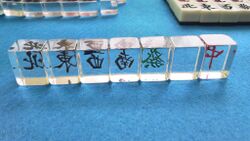Washizu mahjong

Washizu Mahjong is a style of mahjong play, where three tiles for every tile type are transparent. As a consequence, players are able to see most of the other players' hands. That aspect alone alters player approaches to the game in both terms of play style and strategy. The variant originated from the key arc of the 1991 manga series Akagi.
Main game rule differences
The main rules to the game is retained. Rules dictating yaku, furiten, completed hands, and any selected rule variations still apply. Nevertheless, the game is significantly altered.
Game processes are altered, because three-fourths of the tiles are transparent. The tiles are not set up in walls. Likewise, a physical dead wall is not used either. Instead, all the tiles are mixed into a non-transparent bag for players to draw from. To draw tiles, players wear gloves to draw tiles and not read them with the hand. Finally, to mark a dora, one tile is automatically drawn at the beginning of the game. Additional dora as either kandora or any uradora, they are drawn in a similar fashion.
Strategy
External links
- Washizu (YouTube)
- A demonstration how Washizu Mahjong will be played during the 'Washizu in Holland Tournament', Nijmegen, the Netherlands, April 17th, 2010.